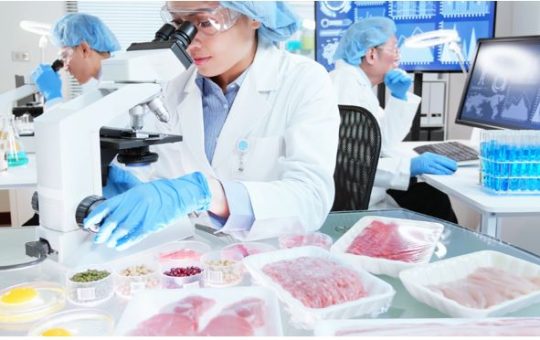
LEVEL 3 AWARD IN FOOD SAFETY FOR CATERING
Level 3 Award in Food Safety for Catering
Course Overview
The Level 3 Award in Food Safety for Catering is a comprehensive qualification aimed at individuals who have responsibility for overseeing food safety practices in catering environments, including chefs, managers, supervisors, and owners of food businesses. This course goes beyond basic food safety and focuses on the advanced management of food hygiene practices, risk assessment, and ensuring compliance with food safety legislation. It’s ideal for those in leadership roles within the food service industry looking to enhance their knowledge and skills in food safety management.
Benefits
- Advanced Knowledge: Gain an in-depth understanding of food safety management practices, regulations, and their application within catering environments.
- Leadership Skills: Develop the skills necessary to manage and supervise food safety practices in the workplace, ensuring the safety of both customers and staff.
- Regulatory Compliance: Learn how to ensure compliance with food safety regulations and implement systems to maintain hygiene standards.
- Enhanced Career Opportunities: Equip yourself with a higher qualification to pursue managerial and supervisory positions in food businesses, enhancing career prospects.
- Reduced Foodborne Illness Risks: Implement advanced safety practices that help to minimize the risk of foodborne illnesses and enhance the overall reputation of your business.
Learning Outcomes
Upon successful completion of the course, learners will be able to:
- Understand and implement food safety management systems in catering environments.
- Conduct risk assessments and apply hazard analysis critical control points (HACCP) principles to control food safety risks.
- Manage the safety of food handling, preparation, cooking, and storage processes.
- Supervise and manage personal hygiene standards for food handlers.
- Identify, assess, and control foodborne hazards, including microbiological, chemical, and physical risks.
- Ensure the maintenance of a hygienic environment through effective cleaning and sanitation practices.
- Ensure compliance with food safety regulations and respond appropriately to audits and inspections.
Study Units
Unit 1: Food Safety Legislation and Standards
- Overview of relevant legislation, food safety regulations, and hygiene standards.
- Roles and responsibilities in ensuring compliance with food safety requirements.
- Understanding the Food Safety Act and other applicable regulations in catering.
Unit 2: Food Safety Management Systems
- Introduction to food safety management systems (FSMS) and HACCP.
- Implementing and maintaining food safety management systems in catering operations.
- How to develop and apply policies for food safety in the workplace.
Unit 3: Foodborne Illnesses and Hazard Control
- Understanding the causes and prevention of foodborne illnesses.
- Identifying and controlling microbiological, chemical, and physical food safety hazards.
- Implementing measures to prevent cross-contamination and food contamination during handling, storage, and service.
Unit 4: Risk Assessment and Food Safety Practices
- How to conduct a food safety risk assessment in catering environments.
- Identifying critical control points in food preparation and service.
- Application of the hazard analysis critical control point (HACCP) principles to reduce risks.
Unit 5: Personal Hygiene and Safe Food Handling
- Importance of personal hygiene and its role in food safety.
- Training food handlers on safe food handling practices and personal hygiene standards.
- Ensuring that food handling equipment is used properly and safely.
Unit 6: Temperature Control and Food Storage
- The importance of temperature control in food safety (e.g., cooking, chilling, and hot-holding temperatures).
- Correct methods for storing food to prevent contamination and spoilage.
- Procedures for monitoring food storage temperatures and maintaining appropriate conditions.
Unit 7: Cleaning and Maintenance of Food Safety
- Procedures for effective cleaning and sanitizing in food preparation and service areas.
- Developing cleaning schedules and ensuring compliance with sanitation standards.
- Preventing the buildup of dirt, grime, and bacteria in food service environments.
Unit 8: Managing Food Safety in the Workplace
- Supervisory and management skills to ensure food safety compliance across the workplace.
- How to manage food safety audits, inspections, and corrective actions.
- Responding to food safety incidents and implementing corrective measures.
Career Progression
The Level 3 Award in Food Safety for Catering is a valuable qualification for those looking to advance in managerial roles in the catering and hospitality industry. Potential career paths include:
- Food Safety Manager: Oversee and manage food safety systems within a catering business.
- Catering Supervisor: Supervise food safety practices and ensure adherence to regulations in a kitchen or catering service.
- Restaurant Manager: Manage food safety and hygiene standards in a restaurant or other food service establishments.
- Chef/Head Chef: Lead food preparation while ensuring compliance with food safety and hygiene standards.
- Health and Safety Officer (Catering): Monitor food safety procedures, conduct inspections, and ensure compliance with local regulations.
- Food Safety Auditor: Conduct audits to assess the food safety practices of catering businesses, ensuring compliance with safety standards.
Additionally, this qualification can serve as a stepping stone for higher-level food safety qualifications and supervisory roles, enabling you to further your career in the food industry.
Our assessment process is designed to ensure every learner achieves the required level of knowledge, skills, and understanding outlined in each course unit.
Purpose of Assessment
Assessment helps measure how well a learner has met the learning outcomes. It ensures consistency, quality, and fairness across all learners.
What Learners Need to Do
Learners must provide clear evidence that shows they have met all the learning outcomes and assessment criteria for each unit. This evidence can take different forms depending on the course and type of learning.
Types of Acceptable Evidence
Assignments, reports, or projects
Worksheets or written tasks
Portfolios of practical work
Answers to oral or written questions
Test or exam papers
Understanding the Structure
Learning outcomes explain what learners should know, understand, or be able to do.
Assessment criteria set the standard learners must meet to achieve each learning outcome.
Assessment Guidelines
All assessment must be authentic, current, and relevant to the unit.
Evidence must match each assessment criterion clearly.
Plagiarism or copied work is not accepted.
All learners must complete assessments within the given timelines.
Where applicable, assessments may be reviewed or verified by internal or external quality assurers.
Full learning outcomes and assessment criteria for each qualification are available from page 8 of the course handbook.
Top Courses
No results found.
Related Courses
Let's Get in touch
Deleting Course Review
Course Access
This course is password protected. To access it please enter your password below:



